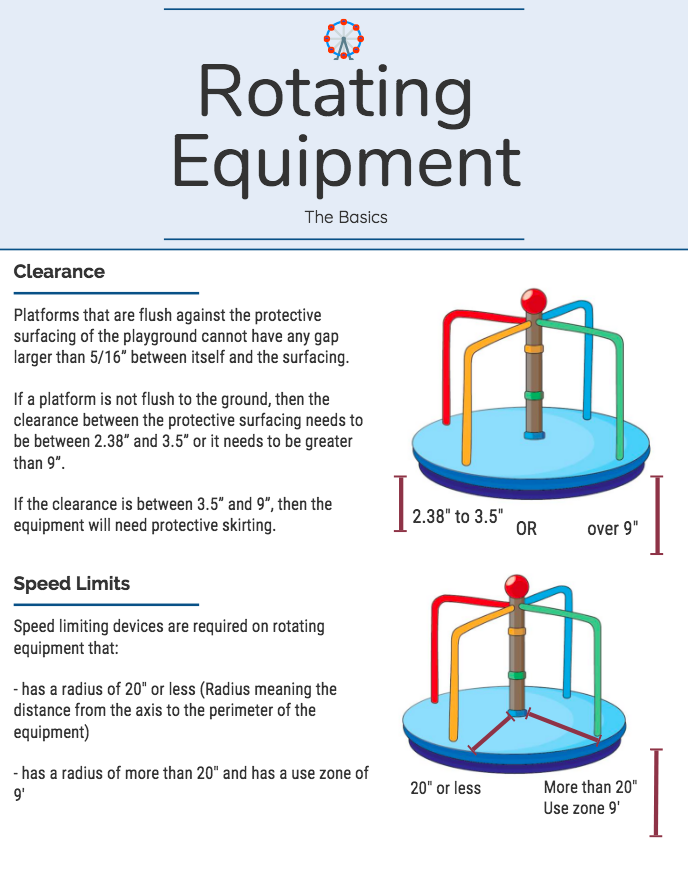Rotating equipment is an element that is designed to repeatedly rotate at any angle while supporting the weight of its users. The equipment needs to be able to meet certain requirements in order to stay safe, especially due to the risk that this equipment poses of ejection and falling. Use zones are particularly important and the equipment cannot be able to move up and down for this reason.
If there are any climbing elements or upper body elements present on the rotating equipment, then it needs to meet the requirements for those kinds of equipment as well. See our other sections for more detailed information on any other equipment that is incorporated on your rotating structure.
Use Zone
Making sure that there is no equipment within the use zone of any rotating elements is extremely important because of the high risk of falling off of this equipment. There can be no other equipment within six feet of the rotating elements. It is important to keep in mind that children can be roughly and quickly ejected from the structure while playing.

Vertical Rotating Equipment
Safety Regulations
There are two different categories of rotating equipment and they depend on the angle at which the axis is installed. Vertical rotating equipment is any kind of equipment that rotates on an axis that is more than 45 degrees from being horizontal.
The size of the equipment is a major factor in the requirements that it needs to meet in order to be safe according to the Certified Playground Safety Inspector Manual. Any equipment that has a perimeter that is more than 20” away from the axis needs to have a circular platform. Any component of the equipment that extends beyond the outer perimeter needs to be designed to minimize the potential for serious injury when a child does fall off.
All vertical rotating equipment needs to either have hand support or a sitting area that is concave enough to hold the children on the equipment to keep them from falling or flying off.
Clearance
Children can also get hurt or stuck if they can get their arms or heads underneath the equipment, and so following clearance regulations are another way in which you can make sure that the equipment is used safely.
Platforms that are flush against the protective surfacing of the playground cannot have any gap larger than 5/16” between itself and the surfacing. If a platform is not flush to the ground, then the clearance between the protective surfacing needs to be between 2.38” and 3.5” or it needs to be greater than 9”. If the clearance is between 3.5” and 9”, then the equipment will need protective skirting. There cannot be anything rigid hanging underneath the platform itself that could interfere with the movement of the equipment.
Equipment is exempt from this requirement if the distance between the axis and perimeter is equal to or less than 20”.
Speed Limiting
Speed is another factor that is a concern when incorporating vertical rotating equipment. Some equipment might need speed limiting devices, but it depends on the design of the particular element. Any rotating elements that have a distance of 20” or less from the axis to the perimeter and any elements larger than 20” that has a use zone of nine feet do not need to have a speed limiting devices.
Horizontal Rotating Equipment
Any rotating equipment that rotates on an axis that is 45 degrees or less than 45 degrees from being horizontal is considered to be horizontal rotating equipment and is less commonly included than vertical rotating equipment. Children under the age of five are more likely to get injured using this equipment, and it is recommended that they do not use it.
Horizontal rotating equipment that is designed for standing needs to have handrails for both mounting and for helping children maintain their balance. These elements need to meet the same requirements as any other handgrip or handrail on your playground. See our section on playground access for more details on handrails.
